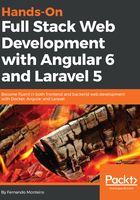
Installing Docker
We will use Docker in this chapter. Even though the official documentation of Laravel suggests the use of Homestead with virtual machines and Vagrant, we chose to use Docker because it's fast and easy to start, and our main focus is on Laravel's core concepts.
As the Docker documentation states:
Let's install Docker, as follows:
- Go to https://docs.docker.com/install/.
- Choose your platform and follow the installation steps.
- If you have any trouble, check the getting started link at https://docs.docker.com/get-started/.
As we are using Docker containers and images to start our application and won't get into how Docker works behind the scenes, here is a short list of some Docker commands:
Command: Description:
docker ps Show running containers
docker ps -a Show all containers
docker start Start a container
docker stop Stop a container
docker-compose up -d Start containers in background
docker-compose stop Stop all containers on docker-compose.yml file
docker-compose start Start all containers on docker-compose.yml file
docker-compose kill Kill all containers on docker-compose.yml file
docker-compose logs Log all containers on docker-compose.yml file